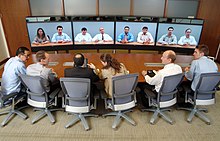Portal:Telecommunication
The Telecommunication Portal

Telecommunication, often used in its plural form, is the transmission of information with an immediacy comparable to face-to-face communication. As such, slow communications technologies like postal mail and pneumatic tubes are excluded from the definition. Many transmission media have been used for telecommunications throughout history, from smoke signals, beacons, semaphore telegraphs, signal flags, and optical heliographs to wires and empty space made to carry electromagnetic signals. These paths of transmission may be divided into communication channels for multiplexing, allowing for a single medium to transmit several concurrent communication sessions. Several methods of long-distance communication before the modern era used sounds like coded drumbeats, the blowing of horns, and whistles. Long-distance technologies invented during the 20th and 21st centuries generally use electric power, and include the telegraph, telephone, television, and radio.
Early telecommunication networks used metal wires as the medium for transmitting signals. These networks were used for telegraphy and telephony for many decades. In the first decade of the 20th century, a revolution in wireless communication began with breakthroughs including those made in radio communications by Guglielmo Marconi, who won the 1909 Nobel Prize in Physics. Other early pioneers in electrical and electronic telecommunications include co-inventors of the telegraph Charles Wheatstone and Samuel Morse, numerous inventors and developers of the telephone including Antonio Meucci and Alexander Graham Bell, inventors of radio Edwin Armstrong and Lee de Forest, as well as inventors of television like Vladimir K. Zworykin, John Logie Baird and Philo Farnsworth.
Since the 1960s, the proliferation of digital technologies has meant that voice communications have gradually been supplemented by data. The physical limitations of metallic media prompted the development of optical fibre. The Internet, a technology independent of any given medium, has provided global access to services for individual users and further reduced location and time limitations on communications. (Full article...)
Selected article -

Videotelephony (also known as videoconferencing or video call) is the use of audio and video for real-time communication between people.
Videophones are standalone devices for video calling. Other devices like smartphones and computers are now capable of video calling. Videoconferencing implies the use of videotelephony for groups. High-quality videoconferencing is used for telepresence, whose goal is to create the illusion that remote participants are in the same room. Videoconferencing has also been called visual collaboration and is a type of groupware. (Full article...)General images
Things to do
 |
Here are some tasks awaiting attention:
|
Selected biography -
Nikola Tesla (/ˈtɛslə/; Serbian Cyrillic: Никола Тесла, [nǐkola têsla]; 10 July [O.S. 28 June] 1856 – 7 January 1943) was a Serbian-American inventor, electrical engineer, mechanical engineer, and futurist. He is known for his contributions to the design of the modern alternating current (AC) electricity supply system.
Born and raised in the Austrian Empire, Tesla first studied engineering and physics in the 1870s without receiving a degree. He then gained practical experience in the early 1880s working in telephony and at Continental Edison in the new electric power industry. In 1884 he immigrated to the United States, where he became a naturalized citizen. He worked for a short time at the Edison Machine Works in New York City before he struck out on his own. With the help of partners to finance and market his ideas, Tesla set up laboratories and companies in New York to develop a range of electrical and mechanical devices. His AC induction motor and related polyphase AC patents, licensed by Westinghouse Electric in 1888, earned him a considerable amount of money and became the cornerstone of the polyphase system which that company eventually marketed. (Full article...)Did you know (auto-generated) -

- ... that when home computers used cassette tapes for storage, the data was sometimes distributed on flexi disc records or even broadcast on radio?
- ... that New Mexico television station KIVA-TV received angry phone calls and a bomb threat after switching away from a tied football game?
- ... that John Seigenthaler hosted a literary interview program which ran for 42 years on Nashville Public Television?
- ... that it was British classicist Courtenay Edward Stevens who suggested that Allied radio broadcasts during the Second World War use the opening notes of Beethoven's Fifth Symphony as a signature theme?
- ... that KMXO near Abilene, Texas, aired the region's first Spanish-language radio program and later became its first full-time Spanish-language station?
- ... that Amrita Shah found that the introduction of television to India led to more women aspiring to become independent?
Related portals
Topics
Subcategories
Associated Wikimedia
The following Wikimedia Foundation sister projects provide more on this subject:
-
Commons
Free media repository -
Wikibooks
Free textbooks and manuals -
Wikidata
Free knowledge base -
Wikinews
Free-content news -
Wikiquote
Collection of quotations -
Wikisource
Free-content library -
Wikiversity
Free learning tools -
Wiktionary
Dictionary and thesaurus




























































































